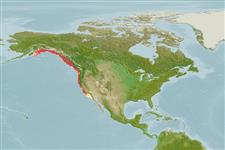Preferred temperature (Ref.
115969): 4.7 - 8.3, mean 5.9 (based on 144 cells).
Phylogenetic diversity index (Ref.
82804): PD
50 = 0.5000 [Uniqueness, from 0.5 = low to 2.0 = high].
Bayesian length-weight: a=0.01000 (0.00499 - 0.02004), b=3.09 (2.92 - 3.26), in cm Total Length, based on LWR estimates for this Genus-body shape (Ref.
93245).
Trofisk nivå (Ref.
69278): 3.8 ±0.61 se; based on food items.
Resiliens (Ref.
120179): Låg, lägsta populationsfördubblingstid 4,5-14 år (tm=7; tmax=84; Musick et al. 2000 (Ref.
36717); Fec=85,000 (annual fecundity)).
Prior r = 0.20, 95% CL = 0.13 - 0.31, Based on 1 full stock assessment.
Fishing Vulnerability (Ref.
59153): High vulnerability (62 of 100).
Climate Vulnerability (Ref.
125649): Moderate to high vulnerability (45 of 100).
